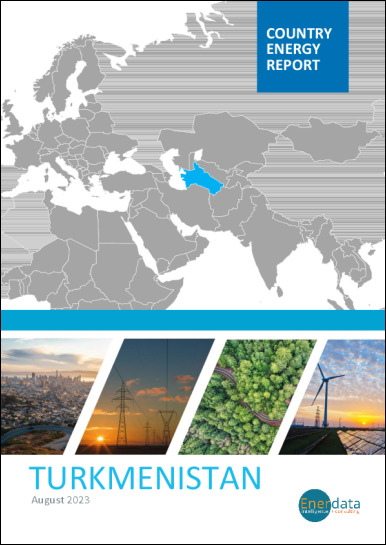- Update
-
- Format
- 3 files (PDF report, 2 Excel files)
- Pages
-
47 (Report only)
- Delivery
- Immediate by e-mail
- GENERAL OVERVIEW
- ENERGY AND CLIMATE POLICY FRAMEWORK
- ENERGY COMPANIES
- ENERGY SUPPLY AND DEMAND
- ENERGY USE AND PRICE BY SECTOR
- ISSUES AND PROSPECTS
- STATISTICS
- ABBREVIATIONS
- GLOSSARY
Buy Turkmenistan energy report
Price without VAT. Depending on your statute and location, VAT might be applicable. Get in touch with us for more information.
After validation, you will immediately receive 3 files by email (one pdf report and 2 excel files containing the datasets).
Overview
Turkmenistan’s energy sector centres on vast natural gas reserves, with exports—primarily to China—driving economic priorities. State-owned enterprises dominate production, while recent policies target efficiency gains and modest renewable expansion. Climate commitments include emission reductions, though fossil fuels remain central to growth.
Get more details on the table of contents and data files, as well as the list of graphs and tables by browsing the tabs below.
Highlights
- The updated NDC aims to reduce GHG emissions by 20% by 2030 (compared to 2010).
- Three state-owned companies have a dominant position: Turkmengaz for gas, Turkmenoil for oil, and Turkmenergo for power.
- Turkmenistan has the world's 5th largest natural gas reserves and is the 8th largest gas exporter.
- Power generation is 100% from gas.
- Gas is by far the main energy source, supplying around 70% of total consumption.
- Gasoline and diesel prices are two times lower than in Russia and 20% lower than in Kazakhstan.
- Turkmenistan aims to more than double its gas exports to China thanks to the commissioning of Line D of the Central Asia-China pipeline.
Energy & Climate Policy Framework
The Ministry of Energy supervises the electricity sector.
The country's priority is to develop gas exports and, to a lesser extent, oil exports.
Energy Companies
Gas:
Turkmengaz is the national gas production and marketing company, that also handles gas exports.
The main foreign companies involved in the development of offshore fields are Eni (production zone of Nebit Dag), Petronas, CNPC and Dragon Oil.
Energy Supply & Demand
Gas:
Gas production decreased by 1.7% in 2024 to 96.3 bcm, after a rapid progression from 2020 to 2023 (6%/year). Since 2010, it has doubled. The most important fields are located in the Amu-Darya Basin in the east of the country. The largest field is Dauletabad-Donmez; according to estimates it could contain half of the country's reserves.
Energy Use and Price by Sector
Energy Prices in Transport:
The prices of gasoline went up by 50% in 2018, with the end of the free supply policy, and remained stable until 2024 (US$0.43/l). The price of diesel increased by 46% between 2017 and 2019 and remained stable until 2023, before decreasing by 24% in 2024 to US$0.29/l, reverting back to 2018 prices.
Issues & Prospects
Foreign investments tend to be more diversified, mainly focusing on the energy sector, but with a growing share allocated to chemicals, especially fertilizers. In total, Turkmenistan planned to spend US$46bn in the oil sector over 2017-2025.
- Graph 1: Primary Consumption Trends by Energy Source
- Graph 2: Total Consumption Market Share by Energy (2024)
- Graph 3: Installed Electric Capacity by Source
- Graph 4: Installed Electric Capacity by Source (2024)
- Graph 5: Gross Power Production by Source & Consumption
- Graph 6: Power Generation by Source (2024)
- Graph 7: Crude Oil Production & Consumption
- Graph 8: Petroleum Products Production & Consumption
- Graph 9: Gas Production & Consumption
- Graph 10: GHG Emissions and CO2-energy Emissions
- Graph 11: Final Demand Trends by Energy Source
- Graph 12: Final Consumption by Sector
- Graph 13: Final Consumption Market Share by Sector (2024)
- Graph 14: Final Consumption in Industry by Energy Source
- Graph 15: Final Consumption in Transport by Energy Source
- Graph 16: Energy Prices Including Taxes in Transport
- Graph 17: Final Consumption in Residential, Services, Agriculture by Energy Source
- Graph 18: Upcoming New Capacity by Energy Source
- Economic Indicators: Annual historical data including population, GDP growth, imports and exports, inflation rate, energy security and efficiency indicators, CO2 emissions.
- Supply Indicators: Historical data including oil and gas reserves, electric and refining capacity, energy production, power production and external trade. All are detailed by energy source.
- Demand Indicators: Historical data including consumption per inhabitant, consumption trends, total consumption by energy source, final consumption by energy source and sector, and electricity consumption by sector.
- Energy Balances: Single table displaying the overall energy industry balance per annum, also graphically displayed by energy sub-segment.
The Turkmenistan energy market data since 1990 and up to
is included in the Excel file accompanying the Turkmenistan country report.
It showcases the historical evolution, allowing users to easily work with the data.
Key Data included in the excelsheet:
- Economic indicators: Annual historical economic indicators, energy security, energy efficiency and CO2 emissions.
- Supply indicators: Annual historical reserves, capacity, production and external trade (imports(+) exports(-) balance).
- Demand indicators: Annual historical consumption per capita, consumption trends, total consumption, final consumption (per energy and per sector) and electricity consumption total and per sector.
- Energy Balance: total and per energy.
- Turkmenistan Energy Prices: In addition to the analysis provided on the report we also provided a data set which includes historical details on the Turkmenistan energy prices for the follow items: price of premium gasoline (taxes incl.), price of diesel (taxes incl.), price of electricity in industry (taxes incl.), price of electricity for households (taxes incl.), price of natural gas in industry (taxes incl.), prices of natural gas for households (taxes incl.), spot price of Brent and CO2 emissions (from fuel combustion).
 Energy and Climate Databases
Energy and Climate Databases Market Analysis
Market Analysis